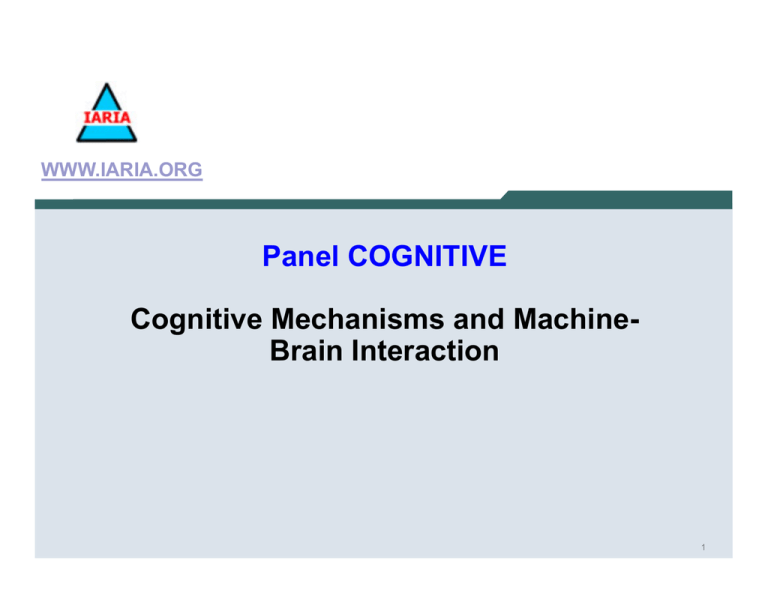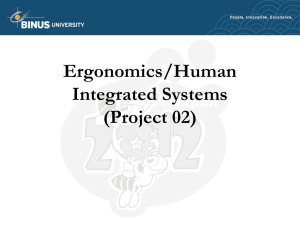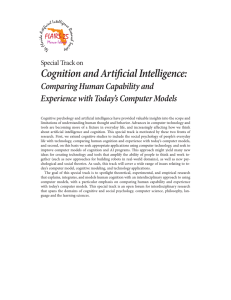Cognitive Mechanisms and Machine-Brain Interaction
advertisement

WWW.IARIA.ORG
Panel COGNITIVE
Cognitive Mechanisms and MachineBrain Interaction
1
Panel
• Moderator
Giorgio Bonmassar, Harvard Medical School, USA
• Panelists
Charlotte Sennersten, CSIRO, Australia
Xia Lin, Drexel University, USA
Hans M. Dietz, University of Paderborn, Germany
Martin Lochner, CSIRO Computational Informatics
(CCI), Australia
2
Brain Maps
and
Information Retrieval
Cognitive 2014 Panel:
Cognitive Mechanisms and Machine-brain interaction
Xia Lin
College of Computing and Informatics
Drexel University
Philadelphia, PA USA
Retrieval of information
Learn from how brain retrieves
information
and apply it to
Information retrieval in databases,
search engines, documents, ……..
Can the brain map help?
Brainmap.org
Everyone Knows but Uncertain
How information is organized in memory
Organized by clustering or chunking ?
Organized by semantic networks ?
Self-organization ?
How information is retrieved from memory
Recall -- direct access
Recognition - Recollection -- reconstruct through logical structures, partial
memories, or clues
Relearning –experiencing the same information multiple
times
BrainMap Indexing
Content Descriptors
"Coordinates: centre of activity"
”Volume of activation"
”Percentage signal change"
”Published statistical parameter: t-score,"
"r-value, z-score and so on"
”Standardized statistical parameter: z-score"
”Significance level"
”Standard anatomical descriptor: Talairach"
"Daemon labels"
”Functional area terms: V1, V2, area MT/V5,"
"supplementary motor area and so on"
BrainMap Indexing
Context Descriptors
Intent: normative mapping, ageing,
development, disease effects and so on
Subjects: number, gender, handedness, diseases and
so on
Behavioural domain: perception, action, cognition,
emotion and so on
Experimental conditions and contrasts
Acquisition modality and methods
Analysis software and methods
BrainMap Sleuth
Lessons Learned
The more detailed indexing, the more accuracy in
retrieval
The map can help to cluster and group information
based on its relevance to specific functionalities
and locations.
Need more analysis and self-organization?
Neurolex.org
Cognitive Atlas
BBC: Human Body & Mind
Mapping functions to areas of the Brain
Neuroscience Literature Retrieval
How libraries organize information
Indexing + Classification
Dewey Classification System:
Classification + self-organization
Zoom-in and Interaction
Another Example
How should the concept “brain” be represented?
A Classification View
A Dynamic View
A Self-Organizing View
Cognition
Brain Dysfunction
Child Education
…based on ERIC
A “Brain” Map based on …
MEDLINE
A Social Classification View
The “BRAIN” Map on Del.icio.us
Conclusions
There is so much we should learn from the brain for
indexing, clustering, and classifying
mapping and organizing knowledge based on
locations and regions
using self-organizing maps to represent concepts
dynamically
enhancing associative retrieval and recollection.
Panel COGNITIVE 2014
Cognitive Mechanisms and Machine Brain Interaction
-volume brain –volume world, adjectives, irrationality and 3D glasses
Dr. Charlotte Sennersten
The volumetric world
The volumetric brain
Action in volume
Computational brain_ volumetric and dynamic comprehension
2 | Presentation title | Presenter name
Is human memory representing past events as 2D representation(s) in the brain?
Is human memory representing future events as 3D representation(s) in the brain?
Does it matter?
3 | Presentation title | Presenter name
Domain of
Adjectives
Cognitive Mechanisms
Explanations > Behaviors > Coping > Cognitive Mechanisms
Description | Example | Discussion | So what?
We cope with difficulties in various ways. Some are more positive than others.
Here are various mental mechanisms that help us cope.
Aim Inhibition: lowering sights to what seems more achievable.
Altruism: Helping others to help self.
Avoidance: mentally or physically avoiding something that causes distress.
Compartmentalization: separating conflicting thoughts into separated
compartments.
Conversion: subconscious conversion of stress into physical symptoms.
Denial: refusing to acknowledge that an event has occurred.
Displacement: shifting of intended action to a safer target.
Dissociation: separating oneself from parts of your life.
Fantasy: escaping reality into a world of possibility.
http://changingminds.org/explanations/behaviors/coping/cognitive_mechanisms.htm
4 | -digital brain, adjectives, irrationality and 3D glasses | Charlotte Sennersten
Rationality versus irrationality in system interaction,
do we design for this?
ir•ra•tion•al•i•ty (ɪˌræʃ əˈnæl ɪ ti)
n., pl. -ties.
1. the quality or condition of being irrational.
2. an irrational action, thought, etc.
http://www.thefreedictionary.com/irrationality
5 | -digital brain, adjectives, irrationality and 3D glasses | Charlotte Sennersten
6 | -digital brain, adjectives, irrationality and 3D glasses | Charlotte Sennersten
Specs appeal: British scientists have made the world's smallest pair of
3D glasses (pictured) for praying mantises to wear
the praying mantis
http://www.dailymail.co.uk/sciencetech/article-2612169/The-praying-mantis-specs-appealScientists-craft-worlds-smallest-pair-3D-glasses-carnivorous-insects.html
7 | -digital brain, adjectives, irrationality and 3D glasses | Charlotte Sennersten
Can Human Cognition Benefit from Machine
Cognition?
Hans M. Dietz
dietz@upb.de
University of Paderborn
Institute of Mathematics
May 29, 2014
IARIA Cognitive 2014 –
Panel Discussion
1/1
Several layers of the question:
Can the "cognition of the human society" benefit from artificial
cognition?
. Certainly YES
. ANY RISKS???
Can (individual) human cognition + AI together perform better?
. Certainly YES
. ANY RISKS???
Can (individual) human cognition (alone) benefit from machine cognition?
. ???
2/1
Recall: Starting point of my talk about "CAT"∗ this morning:
(∗ "CAT - a Semiformal Concept-building Procedure for Teaching Mathematics")
Cognitive sciences
Teaching:
understand, model (!), replicate∗∗ ,... understand, model (?), support,...
... human’s cognitive activities
∗∗
e.g. by AI, "thinking machines"
Open questions in teaching:
(A) support error avoidance
(B) support of abstraction
(C) ...
Today: Focus on error avoidance.
3/1
Recall: CAT supports "reading maths"
from processing symbols, signs and words
up to a valid mental concept
Example: Consider the following piece of text:
Let A denote an arbitrary set and
H := { A | A ⊆ B } ...
4/1
Recall: CAT’s reading procedure:
$
!
%!"&
$
!"
#
"
(
' &
($
()(*
5/1
CAT’s correctness requirements:
6/1
A correct translation result is "guaranteed", given correct ...
... metacognitive process (level) organization
... object classification and choice
... data memorization
...
...
Neither of these is guaranteed in human cognition!
7/1
Some error examples:
(from interviews conducted by J. Rohde under the author’s supervision)
Task example 1:
(Fictious) Definition: A natural number is called "nice", if the series of its
digits contains a "2", or if it contains the factor "2". The task:
Example answers (wrong!) :
(ii) is wrong, as "there is no 2 in the digits", as "a number is nice, if its
digits contain a 2" (neglects 2nd part of the definition)
(iii) "0 can be divided by two and thus, 0 is nice"
(neglects context: 0 is not a natural number.)
8/1
Task example 2: Let A and B be given non-empty subsets of R.
Exemplify
A + B := { a + b | a ∈ A ∧ b ∈ B }.
"Solution" (wrong):
9/1
OBSERVATION:
QUESTION:
HYPOTHESIS:
High complexity of error structures!
How to construct error avoidance strategies?
Much can be gained by ...
... making thinking processes transparent to the thinking persons
... supporting memorization of undispensable basics
10 / 1
CAT’s transparency advice: Use
checklists to monitor regulary working steps
conscious knowledge management
"toolboxes" to support problem solving
...
11 / 1
CAT’s memorization advice: Develop a basic vocabulary
Example entry for "set inclusion":
Vocabulary:
key word:
⊆
definition:
A ⊆ B :⇔ (x ∈ A ⇒ x ∈ B)
syntax: A, B sets
description:
set inclusion symbol
“read out’
“A is a subset of B”
(black parts: recommended categories)
(blue parts: to be inserted in by the students)
12 / 1
CAT’s concept advice: Extend the vocabulary entry to a concept base
Example entry for "power set":
recommended categories | content to be provided by the students
13 / 1
References
Arcavi, A.: The Role of Visual Representations in the Learning of Mathematics.
ESM 52: 215-241, 2003.
Dietz, H.M.: Mathematik fuer Wirtschaftswissenschaftler.
Das ECOMath-Handbuch. Springer-Gabler, 2012.
Dietz, H.M.: Semiotics in Reading Maths In: G. Kadunz (ed.): Semiotische Perspektiven auf das
Lernen von Mathematik (English translation: Semiotic perspectives to the Learning of
Mathematics), Springer, to appear.
Dietz, H. M. and Rohde, J.: Adventures in Reading Maths.
In: Philosophy, Mathematics, Linguistics: Aspects of Interaction. Proceedings of the 2012 PhML
Conference, Steklov Institute of Mathematics and Euler Mathematical Institute, St. Petersburg,
61-68
Tall, D. and Vinner, S.: Concept Image and Concept Definition in Mathematics with Particular
Reference to Limits and Continuity.
Educational Studies in Mathematics 12 (1981) 151-169.
14 / 1
CSIRO Autonomous Systems (AS),
Computational Informatics (CCI), Hobart
Tasmania, Australia
Aristotle’s Categories
http://www.jfsowa.com/ontology/ontoshar.htm
Ontology (1)
“the philosophical study of the nature of being, becoming,
existence, or reality, as well as the basic categories of
being and their relations. “
"What can be said to exist?"
"Into what categories, if any, can we sort existing
things?"
"What are the meanings of being?"
"What are the various modes of being of
entities?"
Wikipedia definition
http://en.wikipedia.org/wiki/Ontology
Ontology (2)
“explicit specification of a conceptualization.“ - Gruber
•
•
•
•
Individuals
Attributes
Relations
Function Terms
•
•
•
•
•
Restrictions
Rules
Axioms
Events
…
Cyc Ontology top level categories CSIRO Autonomous Systems (AS),
Computational Informatics (CCI), Hobart
http://www.jfsowa.com/ontology/ontoshar.htm
Tasmania, Australia
Relation between ontological representation
and a cognitive model
OAR Model of Neural Informatics for Knowledge Representation in
the Brain, Wang 2007
http://enel.ucalgary.ca/IJCINI/ICfCI/IJCINI-1305-OAR-Wang.pdf
Objects, Attributes, and Relations (OAR)
OAR Model of Neural InformaticsCSIRO
for Knowledge
Rep.(AS),in the Brain, Wang 2007
Autonomous Systems
Computational Informatics (CCI), Hobart
http://enel.ucalgary.ca/IJCINI/ICfCI/IJCINI-1305-OAR-Wang.pdf
Tasmania, Australia
Autonomous Systems
OAR Model of Neural InformaticsCSIRO
for Knowledge
Rep.(AS),in the Brain, Wang 2007
Computational Informatics (CCI), Hobart
http://enel.ucalgary.ca/IJCINI/ICfCI/IJCINI-1305-OAR-Wang.pdf
Tasmania, Australia
1. Ontologies (1) formulated to understand the
physical world
2. Information systems ontologies (2) designed
to model human perception of the world
3. Information systems ontologies used as a
basis for modelling human cognition (OAR)
4. Human cognition is therefore (falsely?)
summed to be the total of ontological
relations!!
discussion
• Is LTM (thus, OAR) classification of cognition
sufficient?
• Does viewing cognition through the lens of
current models limit out ability to understand
the actual operation of ‘thinking’?
• NDR’s Problem





